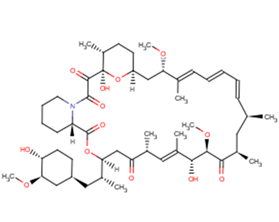No additional charges, what you see is what you pay! *
Stay in control of your spending. These prices have no additional charges, not even shipping!
* Rare exceptions are clearly labelled (only 0.14% of items!).
Multibuy discounts available!
Contact us to find what you can save.
This product comes from:
United States.
Typical lead time:
10-14 working days.
Contact us for more accurate information.
- Further Information
- Documents
- References
- Show All
Further Information
Rapamycin, a macrolide compound obtained from Streptomyces hygroscopicus, is a potent and specific mTOR inhibitor (IC50: 0.1 nM in HEK293 cells).
Bafilomycin A1 is a late-stage autophagy inhibitor. Autophagy, meaning "self-eating", is the cellular process of degrading its own cytoplasmic proteins and damaged organelles using lysosomes. Autophagy serves to prevent cellular damage, promote cell survival under nutrient-deficient conditions, and respond to cytotoxic stimuli. However, excessive autophagy can lead to metabolic stress, degradation of cellular components, and even cell death. Research indicates that autophagy plays a crucial role in various physiological and pathological processes such as cellular homeostasis, aging, immunity, inflammation, tumorigenesis, and neurodegenerative diseases.
53123-88-9
Rapamycin, a macrolide compound obtained from Streptomyces hygroscopicus, is a potent and specific mTOR inhibitor (IC50: 0.1 nM in HEK293 cells). Rapamycin shows potent immunosuppressive properties and induces autophagy.
C51H79NO13
Bafilomycin A1 disrupts the fusion of autophagosomes with lysosomes and the acidification of lysosomes, exerting an inhibitory effect on autophagy. The fusion of autophagosomes with lysosomes and the acidification of lysosomes are late-stage steps in the autophagic process, essential for maintaining functional autophagic flux and cellular homeostasis. Lysosomes are cellular organelles containing hydrolytic enzymes capable of degrading substances such as proteins, nucleic acids, and lipids. Modulating the acidic environment within lysosomes controls the efficiency and speed of their degradation.
Bafilomycin A1 inhibits the function of the V-ATPase within lysosomes, thereby preventing the formation of an acidic environment in lysosomes. Additionally, Baf A1 can inhibit the endoplasmic reticulum calcium ATPase Ca-P60A/SERCA, disrupting the fusion of autophagosomes with lysosomes. By acting at two steps in the autophagy, Baf A1 collectively prevents protein degradation and functional autophagy.
914.18
Microbiology/Virology; Metabolism; Autophagy; PI3K/Akt/mTOR signaling;
0.9873
Cellular homeostasis; Aging; Immunity; Inflammation; Tumours; Neurodegenerative diseases
CO[C@@H]1C[C@H](C[C@@H](C)[C@@H]2CC(=O)[C@H](C)C=C(C)[C@@H](O)[C@@H](OC)C(=O)[C@H](C)C[C@H](C)C=CC=CC=C(C)[C@H](C[C@@H]3CC[C@@H](C)[C@@](O)(O3)C(=O)C(=O)N3CCCC[C@H]3C(=O)O2)OC)CC[C@H]1O
Endogenous Metabolite; Antibiotic; mTOR; Autophagy; Antifungal



